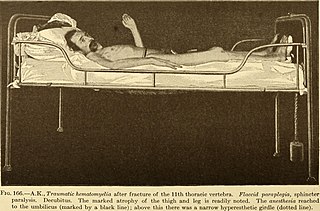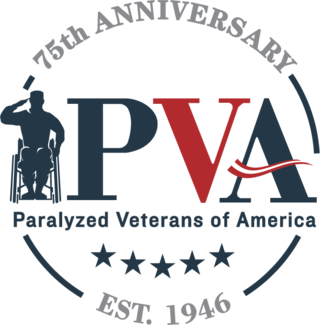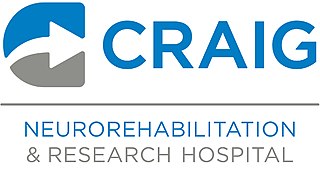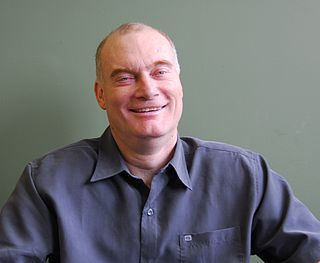Related Research Articles

Paraplegia, or paraparesis, is an impairment in motor or sensory function of the lower extremities. The word comes from Ionic Greek (παραπληγίη) "half-stricken". It is usually caused by spinal cord injury or a congenital condition that affects the neural (brain) elements of the spinal canal. The area of the spinal canal that is affected in paraplegia is either the thoracic, lumbar, or sacral regions. If four limbs are affected by paralysis, tetraplegia or quadriplegia is the correct term. If only one limb is affected, the correct term is monoplegia. Spastic paraplegia is a form of paraplegia defined by spasticity of the affected muscles, rather than flaccid paralysis.

Richard Marvin Hansen is a Canadian track and field athlete, activist, and philanthropist for people with disabilities. Following a pickup truck crash at the age of 15, Hansen sustained a spinal cord injury and became a paraplegic. Hansen is most famous for his Man in Motion World Tour, in which he circled the globe in a wheelchair to raise funds for charity. He was inducted into Canada's Sports Hall of Fame in 2006. He was one of the final torchbearers in the 1988 Winter Olympics and the 2010 Winter Olympics. He was profiled and spoke during the 2010 Winter Paralympics opening ceremony.

Toronto Rehabilitation Institute is the largest rehabilitation hospital in Canada. Owned and operated by the University Health Network (UHN), Toronto Rehab provides patients with rehabilitation care, helping people rebuild their lives and achieve individualized goals following injury and disability. It is composed of five sites across Toronto, which are: Bickle Centre, Lakeside Centre, Lyndhurst Centre, Rumsey Centre, and University Centre.
WheelPower is the national organisation for wheelchair sports in the United Kingdom, and aims to help people with disabilities improve their quality of life.

Vancouver Hospital and Health Sciences Centre (VHHSC) is an acute care hospital affiliated with the University of British Columbia and located in Vancouver, British Columbia. The VHHSC is the second largest hospital in Canada, with 1,900 beds and nearly 116,000 patients each year. VHHSC employs 9500 staff and utilizes 1000 volunteers. As of 2005, the hospital's annual budget is $463 million. It is managed by Vancouver Coastal Health.

The Paralyzed Veterans of America was established in 1946 to serve the needs of disabled veterans. The organization was created to allow its members, veterans of the armed forces living with spinal cord injuries or diseases like multiple sclerosis (MS) and amyotrophic lateral sclerosis (ALS), to live with independence, dignity, and as productive members of society.


Wheelchair racing is the racing of wheelchairs in track and road races. Wheelchair racing is open to athletes with any qualifying type of disability, including leg amputees, spinal cord injuries, and cerebral palsy. Athletes are classified in accordance with the nature and severity of their disability or combinations of disabilities. Like running, it can take place on a track or as a road race. The main competitions take place at the Summer Paralympics which wheelchair racing and athletics has been a part of since 1960. Competitors compete in specialized wheelchairs which allow the athletes to reach speeds of 30 km/h (18.6 mph) or more. It is one of the most prominent forms of Paralympic athletics.
GF Strong Rehabilitation Centre is the largest rehabilitation hospital in British Columbia. It is located in the South Cambie neighbourhood of Vancouver.

Stephanie Cadieux is a Canadian politician, who was elected as a BC Liberal member of the Legislative Assembly of British Columbia in the 2009 provincial election, representing the riding of Surrey-Panorama. After the 2013 provincial election, Cadieux was elected in the riding of Surrey-Cloverdale and in the 2017 provincial election, Cadieux was elected in the riding of Surrey South. She is currently Opposition critic for Advanced Education, having previously served, when her party formed the government, as the Minister of Children and Family Development, and prior to that as Minister of Social Development, Minister of Labour, Citizens' Services and Open Government and Minister of Community, Sport and Cultural Development.
Douglas Lyle Mowat was a Canadian politician, who served as a Social Credit Member of the Legislative Assembly of British Columbia from 1983 to 1991, representing the riding of Vancouver-Little Mountain. A quadriplegic following an accident playing rugby at age 17, Mowat was the first wheelchair user elected to a legislature in Canada.
Magee Rehabilitation Hospital, part of Jefferson Health, founded in 1958, is a 96-bed specialty medical rehabilitation hospital providing physical and cognitive rehabilitation services. Magee's flagship facility is located in Center City Philadelphia. In addition to the main campus that offers comprehensive services for spinal cord injury, brain injury, stroke, orthopaedic replacement, amputation, pain management and work injury, Magee provides an expanding outpatient network serving the surrounding communities. In 1985, Magee's brain injury rehabilitation program became the first in the nation to be accredited by the Commission on the Accreditation of Rehabilitation Facilities. Magee partnered with Jefferson Hospital to create one of the nation's 14 federally designated centers for spinal cord injury rehabilitation. Magee has been rated one of America's leading rehabilitation hospitals by U.S. News & World Report. Magee provides treatment to more than 5,000 individuals annually. Magee is authorized to treat wounded military personnel returning from war. Magee is not an Obligated Group Affiliate.
Shokouh Mirfattah was born on 25 September 1946 in Tehran, Iran. After receiving a bachelor's degree in physical education, she moved to the United States to complete her advanced studies in this field. In 1978, while working on her Ph.D. dissertation at University of Texas in Houston, she got involved in a car accident and became paraplegic.

Dr. Gary Birch, is a Canadian Paralympian, an expert in brain–computer interface (BCI) technology and executive director of the Neil Squire Society. In 1975, Dr. Birch was involved in an automobile accident which resulted in injuries to the C6 and C7 area of his spine making him a low-level quadriplegic. He was one of the original players of Murderball, and won several medals in the 1980 Summer Paralympics in the Netherlands. In 2008, he was appointed an Officer of the Order of Canada. He continues to champion accessibility through his Research and Development work in assistive technologies at the University of British Columbia, the Rick Hansen Institute, and the Neil Squire Society.
The Sporting Wheelies and Disabled Association is the peak body for sport, recreation and fitness for people with a physical disability or vision impairment in the Australian state of Queensland.
Wheelchair Sports NSW is the peak New South Wales sports organisation that assists people with disabilities ranging from spinal cord injury, spina bifida, amputation, paraplegia, quadriplegia to other similar disabling conditions. The organisation was established as the Paraplegic Sports Club, a section of the Paraplegic Association of NSW in October 1961. It offers a range of sports programs, facilities and financial support from beginners to Paralympians.

Although spinal cord injury (SCI) often causes sexual dysfunction, many people with SCI are able to have satisfying sex lives. Physical limitations acquired from SCI affect sexual function and sexuality in broader areas, which in turn has important effects on quality of life. Damage to the spinal cord impairs its ability to transmit messages between the brain and parts of the body below the level of the lesion. This results in lost or reduced sensation and muscle motion, and affects orgasm, erection, ejaculation, and vaginal lubrication. More indirect causes of sexual dysfunction include pain, weakness, and side effects of medications. Psycho-social causes include depression and altered self-image. Many people with SCI have satisfying sex lives, and many experience sexual arousal and orgasm. People with SCI may employ a variety of adaptations to help carry on their sex lives healthily, by focusing on different areas of the body and types of sexual acts. Neural plasticity may account for increases in sensitivity in parts of the body that have not lost sensation, so people often find newly sensitive erotic areas of the skin in erogenous zones or near borders between areas of preserved and lost sensation.

Anthony Eric "Tony" South OAM AM is an Australian Paralympic archer who won a gold medal and two silver medals at the 1968 Summer Paralympics and a bronze medal at the 1972 Summer Paralympics.
Timothy Nugent, who is best known as the "Father of Accessibility," founded the first comprehensive program of higher education for individuals with disabilities in 1948. He served as Professor of Rehabilitation Education and Director of the Rehabilitation Education Center and the Division of Rehabilitation Education Services (DRES) at the University of Illinois. He retired in 1985. He founded the National Wheelchair Basketball Association in 1949 and served as Commissioner for the first 25 years. He also founded Delta Sigma Omicron, a national rehabilitation service fraternity. He was President of the National Paraplegia Foundation for four terms. He has been an international lecturer and consultant, as well as an advocate, publisher, and researcher on behalf of people with disabilities. He was a leader in the development of architectural accessibility standards, public transportation, adaptive equipment, and recreation activities for people with disabilities. He has been and continues to be active in many professional organizations, including the American National Standards Institute, the Illinois State Legislative Commission on the Hospitalization of Spinal Cord Injured, the Committee on Technical Aids, Housing and Transportation of Rehabilitation International, and the Institute for the Advancement of Prosthetics.
Wheelchair sport classification is a system designed to allow fair competition between people of different disabilities, and minimize the impact of a person's specific disability on the outcome of a competition. Wheelchair sports is associated with spinal cord injuries, and includes a number of different types of disabilities including paraplegia, quadriplegia, muscular dystrophy, post-polio syndrome and spina bifida. The disability must meet minimal body function impairment requirements. Wheelchair sport and sport for people with spinal cord injuries is often based on the location of lesions on the spinal cord and their association with physical disability and functionality.
References
- ↑ "More than a quarter of MLAs new" [ permanent dead link ]. Vancouver Province , May 14, 2009.